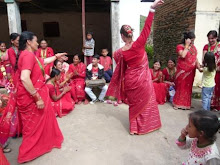

Last weekend a group of us volunteers living in the same region converged in Birgunj, a town an hour and a half south of where I live. It is so far south that you can easily walk to the Indian border. Even though it’s not far from Hetauda, it has a completely different feel: both the town and the people. One of the volunteers living and working there, Samali, had invited us all (5 of us) to her place for lunch.
Constance joined Elijah and I in Hetauda and we left early in the morning on the bus. The bus ride to Birgunj was pretty awful. Traveling on the busses here is one of the hardest things for me. First, there was a man who refused to let Constance sit in the empty seat next to him. He was reserving the seat for his friend, he said. A total lie, which was obvious to all of us. I would have never experienced this as a white foreigner: it is because Constance is black. And it doesn’t happen just sometimes – this is the norm on buses. Ask any of the African volunteers here.
I was pissed. I am used to racism. I see it all the time in the US. We have institutionalized racism. Sometimes overt. Often covert. But usually people who are racist are trained enough to at least pretend they aren’t. It was shocking and angering to me to see my friend so directly discriminated against.
Plus, the busses just aren’t comfortable. You have to crowd in so close to others, knees smashed up against the seat in front of you. It’s not always clear when there will be restroom breaks, though the bus does, indeed, stop at the side of the road from time to time and everyone heads for the forest. Also no such thing as air conditioning in the buses – it is hot here right now.
We entertained ourselves for the first part of the ride by playing games on the bus, singing songs (quietly), and chatting. But the last hour we just grimly sat through, all energy lost for anything other than just surviving the moment.
Visiting with Samali, as well as a Irish/English couple, George and Sheila, from the UK was just what the doctor ordered. I had been in some serious need of relaxing and hanging out time with a group of volunteers: processing our experience, our challenges, what we are learning, the good parts. And Samali’s food was impressive. I have only learned to cook about 15% of the food she has figured out how to cook here with what is local and a two ring burner stove.
As it started to get dark Elijah and I, somewhat reluctantly, headed back to the bus for the trip home, leaving Constance with Samali for a couple days of catching up. After chuckling at the several minutes worth of stares that we got from the folks sitting on the bus (not so many foreigners ever make it to Birgunj, apparently), we settled into the back seats surrounded on both sides by women with large bags of…something. Looked like grains, perhaps. And some seemed to have clothes in them.
The women put the bags of grains carefully on the floor and then placed their feet on the bags, so that – in effect – you couldn’t see there was anything there. The bags of clothes they held on their laps. I didn’t make anything of it at all. But Elijah knew picked up on what was happening. These women were smuggling goods from India.
Our bus was stopped and searched five times along the way by the police. Yes, 5 times. And no one batted an eye. This seemed the most normal thing in the world. Which, I think, it was, as it was evening, and because of the starting location of the bus.
The police seemed to know these women. They knew just where to go and where to look. They asked them questions about what they were carrying, used flashlights to search the floor. Somehow not searching hard enough to see the huge bags of grains under their feet.
I’m not sure if the police just didn’t care so much that night, or if they regularly turn their heads other way, if two foreigners on the bus changed the scenario, or if these feisty women made a good enough case for themselves. Whatever the reason, the police did nothing. They demanded to know what they were hiding, and the women laughed and told them they were being silly- they had absolutely nothing.
Elijah and I were totally entertained by these women. They were loud and funny. They didn’t seem scared, but rather treated the scenario like a game, verbally bantering with the police.
They must have been at least a bit worried, though, because when the woman sitting next to us got up to leave, she gave us a huge smile and seemed relieved to have made it to her destination, still carrying her large bags.
This bus ride was the best bus ride I’ve taken in Nepal so far. The atmosphere on the bus was lively, the police checks provided some interesting entertainment (with just enough worry to make us wonder what might be in store), and I got an insight into a totally different side of Nepal.
I know, I know. Smuggling is supposed to be “wrong”. But I think that smuggling some grains and saris is – in the grand scheme of things – pretty small time business. And I fell in love with those women, bargaining with the police to just let them be. Laughing and smiling as they finished their trip. As we walked to our homes, Elijah and I smiled at their audacity and felt like we had just experienced our own little adventure. The evening’s bus ride, a much more pleasant one than in the morning.

























